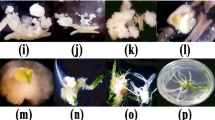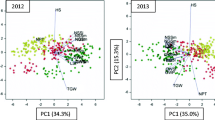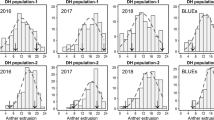Abstract
In cereals, albinism is a major obstacle to produce doubled haploids (DH) for breeding programs. In order to identify QTLs for green plant percentage in barley anther culture, a specific population was developed. This population, consisting of 100 DH lines, was generated by crossing the model cultivar for anther culture “Igri” with an albino-producing DH line (DH46) selected from Igri × Dobla, in search of a maximum segregation for the trait and minimum for the other anther culture variables. A combination of bulked segregant analysis and AFLP methodology was used to identify markers linked to the trait. A linkage map was constructed using these AFLPs, together with RAPD, STS and SSR markers. This study identified a new QTL for green plant percentage on chromosome 3H and confirmed the previously reported one on chromosome 5H. Up to 65.2% of the phenotypic variance for this trait was explained by the additive effects of these two QTLs. Thirty elite cultivars of barley from different origin, row type, growth habit and end use, were selected to validate these QTLs. Since two of the markers linked to the QTLs were AFLPs, we successfully converted them into simple PCR-based SCAR markers. Only the SSR HVM60, on chromosome 3H, was significantly associated with the trait, explaining near 20% of the phenotypic variance. Among the allelic variants identified for this marker, HVM60-120bp was associated with the highest values of green plant percentage.


Similar content being viewed by others
References
Agache S, Bachelier B, De Buyser J, Henry Y, Snape J (1989) Genetic analysis of anther culture response in wheat using aneuploid, chromosome substitution and translocation lines. Theor Appl Genet 77:7–11
Blake TK, Kadyrzhanova D, Shepherd KW, Islam AKMR, Langridge PL, McDonald CL, Erpelding J, Larson S, Blake NK, Talbert LE (1996) STS-PCR markers appropriate for wheat-barley introgression. Theor Appl Genet 93:826–832
Bregitzer P, Campbell RD (2001) Genetic markers associated with green and albino plant regeneration from embryogenic barley callus. Crop Sci 41:173–179
Briard M, Le Clerc V, Grzebelus D, Senalik D, Simon PW (2000) Modified protocols for rapid carrot genomic DNA extraction and AFLP analysis using silver stain or radioisotopes. Plant Mol Biol Rep 18:235–241
Caredda S, Devaux P, Sangwan RS, Clément C (1999) Differential development of plastids during microspore embryogenesis in barley. Protoplasma 208:248–256
Caredda S, Doncoeur C, Devaux P, Sangwan RS, Clément C (2000) Plastid differentiation during androgenesis in albino and non-albino producing cultivars of barley (Hordeum vulgare L.). Sex Plant Reprod 13:95–104
Caredda S, Devaux P, Sangwan RS, Proult I, Clément C (2004) Plastid ultrastructure and DNA related to albinism in androgenetic embryos of various barley (Hordeum vulgare) cultivars. Plant Cell Tiss Org Cult 76:35–43
Castillo AM, Vallés MP, Cistué L (2000) Comparison of anther and isolated microspore cultures in barley. Effects of culture density and regeneration medium. Euphytica 113:1–8
Chen X-W, Cistué L, Muñoz-Amatriaín M, Sanz M, Romagosa I, Castillo AM, Vallés MP (2007) Genetic markers for doubled haploid response in barley. Euphytica 158:287–294
Cistué L, Ramos A, Castillo AM, Romagosa I (1994) Production of large number of doubled haploid plants from barley anthers pretreated with high concentrations of mannitol. Plant Cell Rep 13:709–712
Cistué L, Ramos A, Castillo AM (1999) Influence of anther pretreatment and culture medium composition on the production of barley doubled haploids from model and low responding cultivars. Plant Cell Tiss Org Cult 55:159–166
Cistué L, Vallés MP, Echávarri B, Sanz JM, Castillo AM (2003) Barley anther culture. In: Maluszynski M, Kasha K, Foster B (eds) Doubled haploid production in crop plants. FAO/IAEA Division, Wien, A Manual, pp 29–35
Cistué L, Vallés MP, Echávarri B, Sanz JM, Castillo AM (2004) Production of barley doubled haploids by anther and microspore culture. In: Mujib A, Cho M-J, Predieri S, Banerjee S (eds) In vitro application in crop improvement. Science Publishers Inc., Plymouth, pp 1–17
Collard BCY, Jahufer MZZ, Brouwer JB, Pang ECK (2005) An introduction to markers, quantitative trait loci (QTL) mapping and marker-assisted selection for crop improvement: the basic concepts. Euphytica 142:169–196
Day A, Ellis THN (1984) Chloroplast DNA deletions associated with wheat plants regenerated form pollen: possible basis for maternal inheritance of chloroplasts. Cell 39:359–368
Day A, Ellis THN (1985) Deleted forms of plastid DNA in albino plants from cereal anther culture. Curr Genet 9:671–678
Devaux P, Pickering R (2005) Haploids in the improvement of Poaceae. In: Palmer CE, Keller WA, Kasha KJ (eds) Haploids in crop improvement II. Springer-Verlag, Berlin, pp 215–242
Devaux P, Zivy M (1994) Protein markers for anther culturability in barley. Theor Appl Genet 88:701–706
Dunford R, Walden RM (1991) Plastid genome structure and plastid-related transcript levels in albino barley plants derived from anther culture. Curr Genet 20:339–347
Foroughi-Wehr B, Friedt W, Wenzel G (1982) On the genetic improvement of androgenic haploid formation in Hordeum vulgare L. Theor Appl Genet 62:233–239
Forster BP, Thomas WTB (2005) Doubled haploids in genetics and plant breeding. Plant Breed Rev 25:57–88
González JM, Muñiz LM, Jouve N (2005) Mapping of QTLs for androgenetic response based on a molecular genetic map of x Triticosecale Wittmack. Genome 48:999–1009
Graner A, Jahoor A, Schondelmaier J, Siedler H, Pillen K, Fischbeck G, Wenzel G, Herrmann RG (1991) Construction of an RFLP map of barley. Theor Appl Genet 83:250–256
Grosse BA, Deimling S, Geiger HH (1996) Mapping of genes for anther culture ability in rye by molecular markers. Vortr Pflanzenzeuchtg 35:282–283
Harada T, Sato T, Asaka D, Matsukawa I (1991) Large-scale deletions of rice plastid DNA in anther culture. Theor Appl Genet 81:157–161
Hofinger BJ, Ankele E, Gülly Ch, Heberle-Bors E, Pfosser MF (2000) The involvement of the plastid genome in albino plant regeneration from microspores in wheat. In: Bohanec B (ed) Biotechnological approaches for utilization of gametic cells-COST 824. OP-EUR, Luxembourg, pp 215–228
Knudsen S, Due IK, Andersen SB (1989) Components of response in barley anther culture. Plant Breed 103:241–246
Kosambi DD (1944) The estimation of map distances from recombination values. Ann Eugen 12:172–177
Kwon YS, Kim KM, Eun MY, Sohn JK (2002) QTL mapping and associated marker selection for the efficacy of green plant regeneration in anther culture of rice. Plant Breed 121:10–16
Künzel G, Korzun L, Meister A (2000) Cytologically integrated physical restriction fragment length polymorphism maps for the barley genome based on translocation breakpoints. Genetics 154:397–412
Lander ES, Green P, Abrahamson J, Barlow A, Daly MJ, Lincoln SE, Newberg L (1987) Mapmaker: an interactive computer package for constructing primary genetic linkage maps of experimental and natural populations. Genomics 1:174–181
Larsen ET, Tuvesson IKD, Andersen SB (1991) Nuclear genes affecting percentage of green plants in barley (Hordeum vulgare L.) anther culture. Theor Appl Genet 82:417–420
Lincoln S, Daly M, Lander E (1993) Constructing genetic linkage maps with MAPMAKER/EXP. Version 3.0. Whitehead Institute for Biomedical Research Technical Report, 3rd edn
Manninen OM (2000) Associations between anther-culture response and molecular markers on chromosomes 2H, 3H and 4H of barley (Hordeum vulgare L.). Theor Appl Genet 100:57–62
Mano Y, Takahashi H, Sato K, Takeda K (1996) Mapping genes for callus growth and shoot regeneration in barley (Hordeum vulgare L.). Breed Sci 46:137–142
Melchinger AE, Utz HF, Schön CC (2004) QTL analyses of complex traits with cross validation, bootstrapping and other biometric methods. Euphytica 137:1–11
Michelmore RW, Paran I, Kesseli RV (1991) Identification of markers linked to disease-resistance genes by bulked segregant analysis: a rapid method to detect markers in specific genomic regions by using segregating populations. Proc Natl Acad Sci USA 88:9828–9832
Ramsay L, Macaulay M, degli Ivanissevich S, MacLean K, Cardle L, Fuller J, Edwards KJ, Tuvesson S, Morgante M, Massari A, Maestri E, Marmiroli N, Sjakste T, Ganal M, Owell W, Waugh R (2000) A simple sequence repeat-based linkage map of barley. Genetics 156:1997–2005
Saghai-Maroof MA, Soliman KM, Jorgensen RA, Allard RW (1984) Ribosomal DNA spacer-length polymorphisms in barley: mendelian inheritance, chromosomal location, and population dynamics. Proc Natl Acad Sci USA 81:8014–8018
Sayed H, Kayyal H, Ramsey L, Ceccarelli S, Baum M (2002) Segregation distortion in doubled haploid lines of barley (Hordeum vulgare L.) detected by simple sequence repeat (SSR) markers. Euphytica 225:265–272
Tinker NA, Mather DE (1995) MQTL: software for simplified composite interval mapping of QTL in multiple environments. http://wheat.pw.usda.gov/jag/papers95/paper295/indexp295.html
Torp AM, Hansen AL, Andersen SB (2001) Chromosomal regions associated with green plant regeneration in wheat (Triticum aestivum L.) anther culture. Euphytica 119:377–387
Torp AM, Bekesiova I, Holme IB, Hansen AL, Andersen SB (2004) Genetics related to doubled haploid induction in vitro. In: Mujib A (ed) In vitro application in crop improvement. Science Publishers Inc., Plymouth, pp 34–52
Vos P, Hogers R, Bleeker M, Reijans M, van de Lee T, Hornes M, Frijters A, Pot J, Peleman J, Kuiper M, Zabeau M (1995) AFLP: a new technique for DNA fingerprinting. Nucl Acids Res 23:4407–4414
Xu M, Huaracha E, Korban SS (2001) Development of sequence-characterized amplified regions (SCARs) from amplified fragment length polymorphisms (AFLP) markers tightly linked to the Vf gene in apple. Genome 44:63–70
Zivy M, Devaux P, Blaisonneau J, Jean R, Thiellement H (1992) Segregation distortion and linkage studies in microspore-derived double haploid lines of Hordeum vulgare L. Theor Appl Genet 83:919–924
Acknowledgements
We thank Dr. Salomé Prat for her help with the SCAR development. We are also grateful to C. Andrés, P. Devaux, B. Forster and S. Ullrich for providing the elite cultivar seeds. M. Muñoz-Amatriaín and X.-W. Chen were recipients of a fellowship from Ministry of Education and Science of Spain. The research was supported by Projects AGL2001-1631 and AGL2004-03396 from Plan Nacional de Recursos y Tecnologías Agroalimentarias of Spain.
Author information
Authors and Affiliations
Corresponding author
Rights and permissions
About this article
Cite this article
Muñoz-Amatriaín, M., Castillo, A.M., Chen, X.W. et al. Identification and validation of QTLs for green plant percentage in barley (Hordeum vulgare L.) anther culture. Mol Breeding 22, 119–129 (2008). https://doi.org/10.1007/s11032-008-9161-y
Received:
Accepted:
Published:
Issue Date:
DOI: https://doi.org/10.1007/s11032-008-9161-y




